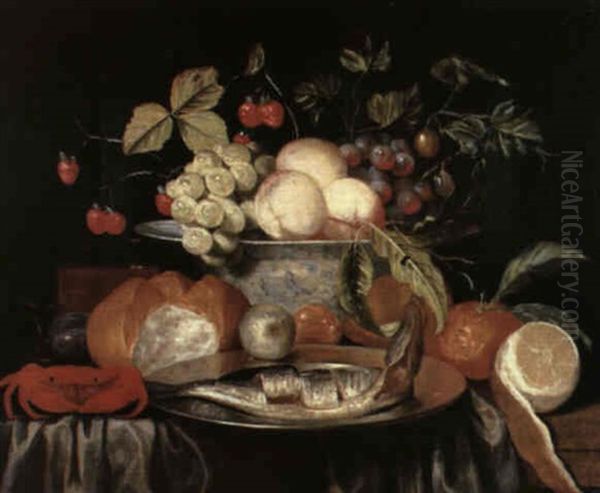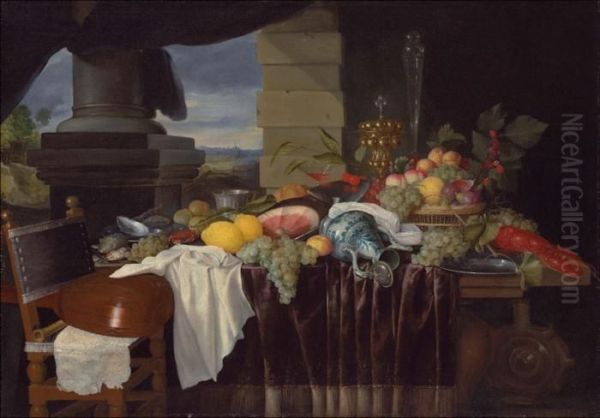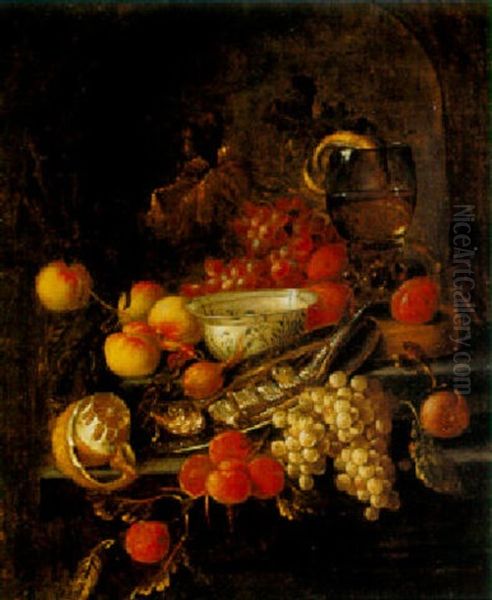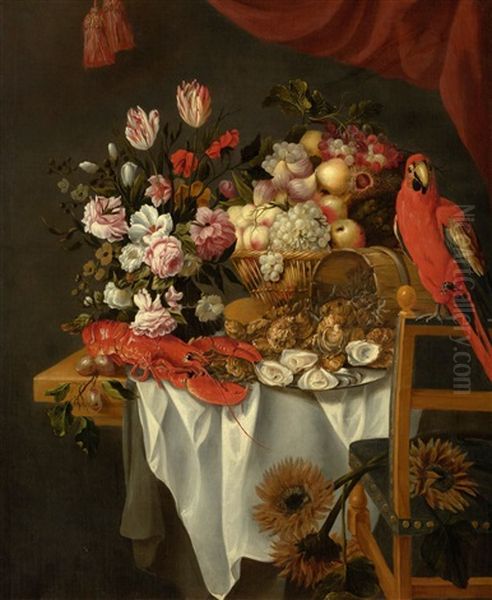Jan Pauwel Gillemans the Elder stands as a significant figure in the rich tapestry of Flemish Baroque art. Active during the mid-17th century, he carved a niche for himself as a highly skilled painter specializing in still lifes. His oeuvre encompasses a variety of popular subgenres, including sumptuous fruit displays, delicate flower pieces, allegorical vanitas paintings, and the opulent pronkstillevens, or lavish still lifes, for which the Antwerp school was particularly renowned. His work is characterized by meticulous detail, a sophisticated understanding of light and texture, and often imbued with subtle symbolism, reflecting the artistic and intellectual currents of his time.
Early Life and Artistic Formation in Antwerp
Reliable records indicate that Jan Pauwel Gillemans the Elder was baptized in Antwerp on September 5, 1618. While some earlier accounts suggested a connection to Liège, this likely stems from the fact that his father, Laurens Gillemans, was a master goldsmith originally from that city who later settled and became a citizen of Antwerp. Growing up in Antwerp, a vibrant hub of artistic production, Gillemans was immersed in a highly competitive and innovative environment.
The specific details of his artistic training remain somewhat obscure. However, the prevailing style in Antwerp during his formative years, particularly in still life, was heavily influenced by masters like Frans Snyders and Adriaen van Utrecht, known for their large-scale market scenes and hunting pieces laden with produce and game. Another crucial figure was the Jesuit painter Daniel Seghers, celebrated for his exquisite flower garlands. Gillemans formally entered the Antwerp Guild of Saint Luke as a master painter in the guild year 1647/1648, signifying his official recognition as an independent artist capable of taking on pupils and selling his work.
Artistic Style: Realism, Detail, and the Influence of Masters

Gillemans the Elder developed a distinctive style marked by careful observation and a high degree of realism. He excelled at rendering the diverse textures of fruits, the delicate petals of flowers, the gleam of metalware, and the transparency of glass. His compositions are often carefully balanced, utilizing a typically Baroque interplay of light and shadow (chiaroscuro) to create depth and drama. Dark, atmospheric backgrounds are common in his works, serving to highlight the illuminated objects in the foreground.
A defining characteristic of Gillemans's art is the palpable influence of Jan Davidsz. de Heem, a highly celebrated still life painter who worked in both Utrecht and Antwerp. While no documentary proof confirms Gillemans was de Heem's direct pupil, the stylistic parallels are undeniable. Gillemans adopted de Heem's refined approach to composition, his rich colour palette, and his penchant for depicting luxurious items alongside natural elements. Several works by Gillemans closely echo de Heem's arrangements, featuring similar motifs like peeled lemons, oysters, elaborate goblets, and Persian carpets. One instance even involves Gillemans creating a near-copy of a de Heem still life, signed in Antwerp.
Another contemporary whose influence can be discerned, particularly in Gillemans's handling of fruit and garland elements, is Joris van Son. Van Son was another prominent Antwerp still life specialist, and the relationship between the two artists appears to have been close, extending beyond mere stylistic affinity. This connection underscores the collaborative and mutually influential nature of the Antwerp artistic community.
The World of Pronkstillevens: Opulence and Display
Gillemans excelled in the genre of the pronkstilleven, or sumptuous still life, a type of painting that emerged in Antwerp around the 1640s and quickly gained popularity. These works were designed to showcase abundance, wealth, and often, the collector's sophisticated taste. They typically feature a lavish display of expensive objects: silver and gold vessels, imported Chinese porcelain (often blue-and-white Kraak ware), Venetian glassware, exotic fruits like oranges and lemons, seafood delicacies such as lobsters and oysters, and rich textiles like velvet drapery or oriental rugs.
Gillemans's pronkstillevens are masterful examples of the genre. He skillfully arranged these diverse elements into complex, often asymmetrical compositions that delight the eye with their variety of colours, textures, and forms. Works like Still life with a fountain decorated with a swag of fruit exemplify this approach, combining natural elements (grapes, peaches, pomegranates) with man-made luxury items and architectural features, creating a scene of opulent display. These paintings were not merely decorative; they often carried underlying moral or symbolic messages.
Fruit and Flower Pieces: Nature's Bounty and Transience

Beyond the overtly luxurious pronkstillevens, Gillemans was also a master of fruit and flower painting. Antwerp had a long and distinguished tradition in this field, stretching back to Jan Brueghel the Elder. Gillemans continued this legacy, creating compositions that celebrated the beauty and diversity of nature's bounty. His fruit pieces, such as Still life with a plate of fruit, often depict grapes, peaches, plums, cherries, and melons, rendered with remarkable verisimilitude.
His flower paintings showcase a similar attention to detail, capturing the delicate structure and vibrant colours of tulips, roses, carnations, and other blooms. Often, these natural elements were combined with insects like butterflies or snails, adding another layer of realism and, frequently, symbolism. Flowers, in the 17th-century context, could symbolize the beauty but also the brevity of life, echoing the vanitas theme prevalent in Baroque art. Gillemans sometimes incorporated these elements into garland paintings, a subgenre popularized by Daniel Seghers, where swags of fruit or flowers encircle a central motif, which might be a religious scene, a portrait, or a grisaille cartouche, sometimes painted by another artist.
Vanitas: Reflections on Mortality and Earthly Vanity
Like many artists of his time, particularly in the Low Countries where Calvinist thought emphasized worldly detachment, Gillemans engaged with the vanitas theme. Vanitas still lifes aimed to remind the viewer of the transience of life, the futility of earthly pleasures, and the inevitability of death. Common symbols used in these paintings include skulls, hourglasses, snuffed-out candles, soap bubbles, wilting flowers, and decaying fruit.
While perhaps less overtly focused on vanitas motifs than some contemporaries like Harmen Steenwijck or Pieter Claesz in the Dutch Republic, Gillemans often incorporated subtle vanitas elements into his more opulent compositions. The presence of insects, slightly overripe fruit, or flowers past their prime could serve as gentle reminders of decay and the passage of time, adding a layer of moral reflection beneath the surface of luxurious display. This blend of sensual appeal and moral undertone was characteristic of much Baroque still life painting.
Representative Works: A Closer Look
Several works stand out as representative of Jan Pauwel Gillemans the Elder's skill and typical subject matter. Still life with a plate of fruit showcases his ability to render textures and arrange common elements into a pleasing composition, likely focusing on the beauty of natural forms.

Still life with a fountain decorated with a swag of fruit is a more elaborate piece, leaning towards the pronkstilleven genre. The inclusion of architectural elements like the fountain, combined with the rich swag of fruit, demonstrates his compositional ambition and his ability to integrate diverse elements into a harmonious whole. This work likely emphasizes themes of abundance and perhaps the contrast between enduring stone and perishable nature.
Still life with a crayfish (or lobster, as often depicted) highlights his skill in rendering seafood, a common motif in luxury still lifes. The bright red shell of the cooked crustacean would provide a striking colour contrast against darker elements, showcasing his command of colour and texture. Such items symbolized wealth and luxury, as they were expensive delicacies. These works demonstrate his versatility within the still life genre, from simpler arrangements to complex, symbolic displays.
Collaborations, Contemporaries, and Artistic Circle
The Antwerp art scene in the 17th century was characterized by specialization and collaboration. While Gillemans primarily focused on the still life elements, it's possible he collaborated with figure painters for works that required human subjects or specific mythological or religious scenes within garlands, although documented collaborations are scarce for him specifically. Artists like Erasmus Quellinus II, Thomas Willeboirts Bosschaert, and Cornelis Schut were known to collaborate with still life specialists in Antwerp.
Gillemans operated within a rich network of still life painters. Besides the aforementioned Jan Davidsz. de Heem and Joris van Son, other key figures in Antwerp included the pioneers Frans Snyders and Adriaen van Utrecht, the meticulous Alexander Adriaenssen, the early master Osias Beert, and painters specializing in game pieces and animals like Jan Fyt and Pieter Boel. Hieronymus Galle I was another contemporary known for fruit and flower pieces. Comparing Gillemans's work to Dutch contemporaries like Willem Kalf or Abraham van Beyeren, who also excelled in pronkstillevens, reveals regional nuances within the broader genre. Gillemans's style generally retains a Flemish robustness compared to the often more restrained elegance of the Dutch masters.
His close personal connection with Joris van Son is evidenced by the fact that Gillemans served as the godfather to van Son's son, Jan Frans van Son, who also became a painter. This familial tie suggests a strong professional and personal relationship, likely involving mutual artistic exchange.
Family, Workshop, and Teaching

In 1648, shortly after becoming a master, Jan Pauwel Gillemans the Elder married Paulina Uyt den Eeckhout. The couple went on to have eight children. His artistic legacy was most directly continued by his son, Jan Pauwel Gillemans the Younger (1651–1704), whom he presumably trained. Gillemans the Younger largely followed his father's style, particularly in fruit and flower painting, though his work sometimes shows a slightly looser handling. He later moved and worked in Middelburg and eventually Amsterdam.
Gillemans the Elder also took on other pupils in his workshop. Documented students include Frans van Everbroeck, who became a successful still life painter in his own right, known for his fruit pieces and vanitas works, and Norbert Montalie. Through his teaching, Gillemans helped perpetuate the traditions and techniques of Antwerp still life painting into the next generation. His typical signature varied, using "J.P. Gillemans" or, particularly from the late 1650s onwards, "Joannes Gillemans".
Later Years, Death, and Lasting Legacy
Jan Pauwel Gillemans the Elder remained active as a painter in Antwerp throughout his career. The available records suggest he worked steadily, producing the detailed and often luxurious still lifes that were clearly in demand. He passed away in his native city and was buried on August 10, 1675, at the age of 57.
In the annals of Flemish art history, Gillemans the Elder holds a secure place as a leading still life painter of the mid-17th century. While perhaps overshadowed in broader recognition by the towering figure of Jan Davidsz. de Heem, Gillemans was a highly accomplished artist who mastered the key genres of his specialization. His pronkstillevens contribute significantly to the Antwerp school's fame for this opulent style, and his fruit and flower pieces uphold the city's long tradition of excellence in depicting nature's bounty.
His influence extended through his son and pupils, ensuring the continuation of his artistic concerns. Today, his works are held in the collections of major museums worldwide, including the Royal Museums of Fine Arts of Belgium in Brussels, the Prado Museum in Madrid, the Louvre in Paris, the Rijksmuseum in Amsterdam, the Victoria and Albert Museum in London, and many others. His paintings continue to be appreciated by collectors and scholars, appearing regularly on the art market, where they command respect for their technical skill, aesthetic appeal, and historical significance as prime examples of Flemish Baroque still life.
Conclusion: An Enduring Contribution to Still Life

Jan Pauwel Gillemans the Elder was a quintessential Antwerp still life painter of the Baroque era. Working within established traditions but developing his own refined style under the significant influence of masters like Jan Davidsz. de Heem, he produced a body of work celebrated for its meticulous realism, rich detail, and often complex compositions. Whether depicting lavish displays of luxury goods in his pronkstillevens, the vibrant beauty of fruit and flowers, or contemplating mortality through vanitas symbolism, Gillemans demonstrated exceptional skill and sensitivity. His legacy endures not only through his surviving paintings housed in prestigious collections but also through the artists he trained, solidifying his position as an important contributor to the golden age of Flemish still life painting.